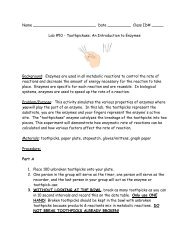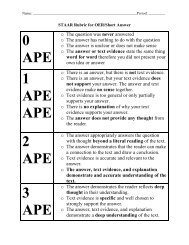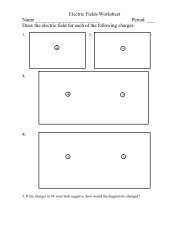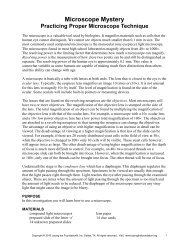Derivatives Worksheet
Derivatives Worksheet
Derivatives Worksheet
Create successful ePaper yourself
Turn your PDF publications into a flip-book with our unique Google optimized e-Paper software.
<strong>Derivatives</strong> <strong>Worksheet</strong>AP Physics CFor problems 1 – 8, find the derivative of y with respect to x.dy1. y = 5 0dx2. y = x 4 dy4x3dx3. y = 7x 4 + 9x 3 + 3x + 24. y = (2x 3 – 4x 2 )(3x 5 + x 2 )5.y36. y5x3 2x3 2xdydxdydxdydx123 2x15xdydx263 228x27x348x 84x 10x 16xdy7. y 3sin x 2cos x 3cos x 2sin xdxdy8. y 5cos(3x 2)15sin 3x2dxFind v(t) and a(t) for the following position vectors:9.7 6 4 32r( t) (5t 3 t) iˆ 5 ˆj v t 10t 3 i ˆ ; a t 10iˆ10.r( t) 5 tiˆ(3t 5 t ) ˆj (4t 6t 4) ka t 18t 10 ˆj 8kˆ3 2 2 ˆv t 5iˆ9t 10t ˆj 8t 6 k ;2 ˆ11. r( t) ( Acos t) iˆ ( Asin t)ˆj v t Asint iˆ Acost ˆj ;2 2a t Acost i Asint jSolve the following problems:12. For the equationˆ2y x 4x 3, findˆdya. The equation for the slope of its tangent line at any point 2x4dxb. The equation of the tangent line at the point (4,3) using the point slope form. (y-y′) = m(x- x′) At x = 4, m = 4; y 3 4 x 4 so y 4x1323t13. A point moves along the curve y x 3x 5 so that x 3 , where t is the elapsed time. At2what rate is y changing (the y component of velocity) when t = 4 s? (hint: use the chain rule.)
<strong>Derivatives</strong> <strong>Worksheet</strong>AP Physics Cdydxdydt23x3 anddxdttFrom the chain rule:t2223x 3 t and since x 3derivative function and simplifying, we get:dy dy dxdt dx dtSothe value of x at t = 4 is 11. Substituting x = 11 and t = 4 into thedydt1440 m s14. A particle undergoes straight-line motion with its displacement at any time given by the3 2following equation: x 2t 4t 2t 5. Find:a. The times at which the particle is motionless. t = ⅓s, t = 1sb. The time at which it is moving to the right. when t > 1 and when t < ⅓c. The times at which it is moving to the left. when ⅓ < t < 1dx 2The particle will be motionless when the velocity = 0; 6t8t2 Set equal to 0 and solvedtfor t. Alternatively, plot the velocity function to find the values for t when v = 0The particle will move right when v is positive and left when v is negative.
















